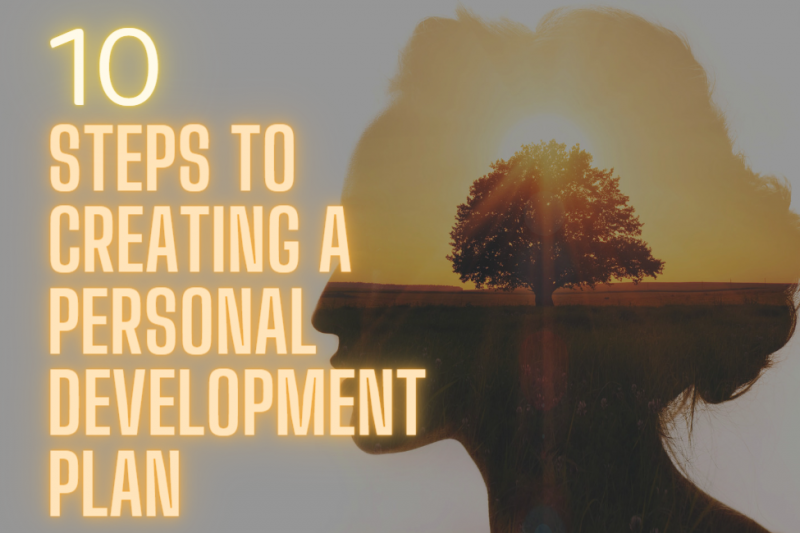Introduction
You’re on a journey to personal growth, and you need a roadmap. That’s where a personal development plan comes in handy. It’s your guide to improve, grow, and reach your potential. So, don’t just let life happen to you; take control.
We’ll show you ten steps to craft your own plan. You’ll identify strengths, set goals, track progress, and more. Ready to start?
Let’s map your journey to success.
Understanding Personal Development
Before diving into the creation of your personal development plan, it’s crucial to gain a clear understanding of what personal development actually entails. Essentially, it’s about making conscious efforts to improve your life, whether it’s your career, relationships, health, or even your hobbies. It’s not simply about achieving goals, but growing as an individual and enhancing your quality of life.
You’re not just ‘going with the flow’, you’re creating your own current. It’s about acknowledging your weaknesses and working hard to overcome them. It’s also about leveraging your strengths to achieve your aspirations. It’s an ongoing process, not a one-time event. It’s a journey, not a destination.
Personal development also entails learning new skills, adapting to change, and fostering a positive attitude. It’s about becoming more self-aware, understanding your values, and aligning your actions with them.
Assessing Your Current Status
Before you start planning your journey, it’s crucial to know where you’re starting from.
You’ll need to identify your strengths and weaknesses, understand your personal values, and evaluate your life balance.
These steps will give you a clear picture of your current status and what areas you need to focus on for your personal growth.
Identifying Strengths and Weaknesses
In your journey to personal growth, it’s crucial to kick-start your self-assessment by identifying your core strengths and potential weaknesses. Your strengths are the skills and abilities you’re naturally good at or have honed over time. They’re your unique selling points and can propel you towards your goals.
Your weaknesses, however, are areas where you may lack proficiency or struggle to perform effectively. Don’t fret over these weaknesses; instead, view them as opportunities for improvement. Remember, nobody’s perfect. You’re not expected to excel in every area.
The key is to be honest with yourself. By accurately identifying these elements, you’re setting the groundwork for a comprehensive personal development plan that’s tailored to your needs and aspirations. This is your growth roadmap, and it starts with you.
Understanding Personal Values
Moving on, it’s time to delve into your personal values to better assess where you currently stand in your self-improvement journey. Your values serve as a compass, guiding you in decision-making and shaping your overall behavior. They’re the principles you hold dear and the standards you won’t compromise on.
Start by listing down what you value the most – honesty, family, health, career, or perhaps personal growth. Reflect on how these values align with your actions and decisions, and if they’re being met in your current situation. Are you living in harmony with what you value or are there contradictions?
Identifying any discrepancies is the first step to aligning your life with your values, setting the stage for meaningful growth and development.
Evaluating Life Balance
Now that your values are clearly defined, it’s crucial to evaluate your life’s balance and assess where you currently stand. This involves looking at the different areas of your life – your career, relationships, health, personal growth, and leisure, among others. Are you spending too much time in one area at the expense of the others? If so, then that’s a sign your life may be out of balance.
It’s not about achieving perfect equilibrium. Instead, it’s about creating a blend that aligns with your values and makes you feel fulfilled. Remember, you’re crafting a roadmap for personal development. Hence, recognizing where you’re now is an essential step.
This assessment will help you identify the areas you need to focus on for growth and satisfaction.
Identifying Your Strengths and Weaknesses
Now, it’s time to explore your strengths and weaknesses.
Self-assessment techniques will help you identify what you’re good at and where you might need some work.
Understanding and dealing with your weaknesses are key to personal growth and creating a solid development plan.
Self-Assessment Techniques
To kick-start your personal development journey, you’ll first need to identify your strengths and weaknesses through effective self-assessment techniques. This isn’t just about figuring out what you’re good or bad at, but it’s about understanding where you excel and where you could use improvement.
Start by writing down what you believe are your strengths and weaknesses.
Next, ask others for their opinions, as they may see things you don’t.
Take personality and skills tests, like Myers-Briggs or StrengthsFinder, for a more objective view.
Reflect on past experiences, both successful and not, to identify patterns.
Finally, remember this is an ongoing process. You’re constantly evolving, and so will your strengths and weaknesses.
This self-awareness will pave the way for your personal development.
Dealing With Weaknesses
In the process of personal growth, acknowledging your weaknesses is as crucial as recognizing your strengths. It’s not about dwelling on the negatives but rather identifying areas for improvement. Remember, everyone has weaknesses – they’re not a reflection of failure, but opportunities for growth.
Start by taking an honest look at yourself. Ask for feedback from trusted individuals who know you well. This insight can help pinpoint areas you might overlook.
Once you’ve identified your weaknesses, don’t be disheartened. Instead, create a plan to work on them. Set realistic goals and track your progress. Overcoming weaknesses won’t happen overnight, but with dedication and persistence, you’ll strengthen these areas and foster personal growth.
Always keep in mind, self-improvement is a journey, not a destination.
Setting Your Personal Goals
Having established your vision, you’re ready to start setting personal goals that will steer your growth journey. Personal goals are the stepping stones that’ll guide you towards your ultimate vision. They’ll provide you with a sense of direction and motivation.
Start by identifying what you want to achieve. It’s important to ensure these goals align with your broader vision and personal values. Once you’ve identified your goals, you’re ready to break them down into manageable steps. Each step should be a mini-goal, achievable, and measurable to track your progress.
Writing your goals down is crucial. It not only helps you remember them but also serves as a constant reminder of what you’re striving for. Be specific about what you want, why you want it, and by when you aim to achieve it.
Remember to set SMART goals – Specific, Measurable, Achievable, Relevant, and Time-bound. This approach ensures that your goals are clear and reachable.
It’s also essential to review and adjust your goals periodically, as your circumstances and priorities might change. So, stay flexible and open to adjustments.
You’re now on your way to personal growth!
Prioritizing Your Objectives
After setting your personal goals, it’s crucial to prioritize your objectives. You’ll want to identify key objectives and rank them in order of importance.
Identifying Key Objectives
On your journey towards personal growth, it’s crucial that you start by identifying and prioritizing your key objectives. These are the goals that will guide your actions, decisions, and efforts.
Think about what you want to achieve, improve, or change in your personal or professional life. It could be about enhancing a skill, changing a habit, or achieving a career milestone.
Once you’ve identified your key objectives, assess their importance and urgency. Prioritize them based on their significance to your overall growth. Remember, it’s not about the number of objectives but their quality and relevance.
Also, be realistic in setting them. You’ll be more motivated to pursue goals that are challenging yet achievable. This step will provide a clear direction to your personal development plan.
Ranking Objectives’ Importance
Now it’s time for you to rank your objectives based on their importance and relevance to your personal growth. Not all goals are created equal, and it’s crucial you understand this.
Start by listing your objectives, then assign each one a rank. This ranking should reflect how essential it’s to your overall development.
Some goals might’ve immediate effects on your life, while others could lead to long-term changes. Consider the potential impact of each objective. For instance, improving your public speaking skills might’ve a more significant effect than learning a new hobby.
Re-evaluating Priorities Regularly
Why should you regularly reassess your priorities in your personal development plan?
Life isn’t static – your circumstances, interests, and values can change over time. It’s essential that your personal development plan remains flexible to accommodate these shifts.
By re-evaluating your priorities regularly, you’re making sure your plan stays relevant and effective.
Think of it like a GPS recalculating your route when you take a detour. If a priority becomes less relevant or another becomes more urgent, don’t hesitate to adjust your plan.
Remember, it’s your roadmap towards growth and should reflect your current reality and future aspirations.
Regularly reassessing your priorities isn’t a sign of lack of focus, but rather a proactive approach to personal development.
Developing a Skill Enhancement Plan
Start by identifying the skills you need to enhance to reach your personal development goals. This could be anything from public speaking to time management. Be honest with yourself about your current abilities and where you’d like to improve.
Once you’ve identified these skills, it’s time to develop a plan to enhance them. Create a schedule that allocates regular, consistent time for skill development. You’re more likely to stick to your plan if you integrate it seamlessly into your daily routine.
Next, find resources that’ll help you improve. You might enroll in a course, hire a coach, or find books and online materials to study. It’s crucial to choose resources that are engaging to you, as this will keep you motivated throughout your journey.
Remember, skill enhancement is a process, not a destination. You won’t become an expert overnight. It’s important to celebrate small victories along the way. By tracking your progress, you’ll see how far you’ve come and stay motivated to keep going.
Ultimately, developing a skill enhancement plan is a key step in your personal development journey. It’s your roadmap to becoming the best version of you.
Implementing Your Personal Growth Plan
Once you’ve crafted your personal growth roadmap, it’s time to put your plan into action. You’ve identified your goals, mapped out your skills, and now you’re ready to take the next step. But how exactly do you go about implementing your personal growth plan?
Start by ensuring you’ve set realistic, achievable goals. Don’t set yourself up for failure by expecting too much too soon. Remember, it’s about progress, not perfection.
Next, consider breaking down your larger goals into smaller, manageable tasks. This makes the process less overwhelming and gives you a sense of accomplishment as you tick off each task.
Commit to your plan by setting aside time each day or week to work on your goals. Consistency is key here. Don’t underestimate the power of a steady, consistent effort.
Monitor your progress regularly. This will help you stay motivated, identify any obstacles, and make necessary adjustments to your plan. Celebrate your victories, no matter how small, and learn from your setbacks.
Implementing your personal growth plan isn’t always easy, but with determination, consistency, and a positive mindset, you’re sure to see progress. Remember, you’re on a journey, and every step brings you closer to your goal.
Tracking Your Progress Regularly
Keeping track of your progress is a crucial part of your personal development journey. It’s important to remember that growth isn’t always linear. There’ll be ups and downs, but what matters is regular checking in with yourself to see how you’re doing.
You can’t measure progress without a baseline, so start by identifying where you’re now. Take note of your starting point in terms of skills, knowledge, and experiences. You’ll use this as the benchmark against which to measure your growth.
Next, set up a system to monitor your progress. This could be a journal where you jot down your daily achievements and challenges, or a more formal tracking sheet that records specific metrics related to your goals.
Remember to review your progress regularly. Whether it’s weekly, monthly, or quarterly, set aside time to reflect and assess. Are you moving closer to your goals? If not, what’s holding you back? Don’t be discouraged if progress is slow. Growth takes time and patience, but with regular tracking, you’ll be more aware of your progress, helping you stay motivated and focused.
Lastly, celebrate your wins, no matter how small. They’re proof that you’re growing and moving forward.
Adapting to Change and Evolution
As your journey unfolds, you’ll inevitably encounter changes and evolution in your personal development roadmap. These variations aren’t setbacks; they’re part of the growth process. Embracing change, as opposed to resisting it, is crucial to your progression. You can’t grow if you’re stagnant, after all.
But how do you adapt to change? First, maintain an open mind. You can’t predict every twist and turn, so flexibility is key. See these shifts as opportunities for learning and growth, not obstacles.
Next, reassess your plan regularly. This isn’t about scrapping your goals, but about tweaking them. If a particular method isn’t working anymore, don’t be afraid to try something new. Remember, the goal is your development, not adhering rigidly to a plan.
Lastly, welcome feedback. Constructive criticism can help you identify areas for improvement that you might’ve overlooked. It’s not always easy to hear, but it’s often necessary for growth.
Constantly Reviewing and Updating Your Plan
Over time, it’s essential for you to continuously review and update your personal development plan to align with your growth and the changes you’re experiencing. Life isn’t static, and neither should your plan be. It’s a living document that must adapt as you evolve.
You’ve got to regularly scan your plan, identify areas where you’ve grown, and modify the targets that don’t serve your current situation. Revisiting and tweaking your plan doesn’t mean you’re off track, but it’s a sign that you’re conscious of your development.
Moreover, it’s crucial to ensure that your plan remains relevant and effective. You may discover that some goals are no longer feasible, or perhaps your priorities have shifted. That’s okay. It’s your plan, and it’s meant to serve you, not dictate your life.
Additionally, it’s vital to celebrate the victories along the way. Each achieved goal, no matter how small, is a testament to your progress. Recognizing these successes can boost your motivation and confidence, propelling you to achieve more.
In short, constantly reviewing and updating your plan is as essential as setting it up. It’s a cycle of growth that keeps you moving forward.
Frequently Asked Questions
What Is the Best Time to Start Creating a Personal Development Plan?
The best time to start creating a personal development plan is now. There’s no perfect moment. It’s about you deciding to take control of your growth and development.
It doesn’t matter where you’re at in your life or career; it’s never too late or too early to start. So, grab a pen, sit down, and begin to outline your goals, skills, and steps you’ll take.
How Long Does It Usually Take to See Results From a Personal Development Plan?
You’re curious about how long it’ll take to see results from a personal development plan. It’s not an overnight process.
The time frame varies from person to person, depending on individual goals, dedication, and consistency.
Typically, you might start seeing small changes in weeks or months.
Major transformations, however, may take years.
Remember, it’s a journey of personal growth, so don’t rush.
Patience and persistence are key.
Are There Any Recommended Tools or Apps to Help Manage and Track a Personal Development Plan?
Yes, there are several tools and apps that can help you manage and track your personal development plan. Trello, Asana, and Evernote are great for organization and task management.
For habit tracking, try apps like Habitica or Strides.
If you’re focusing on learning new skills, platforms like Coursera or Skillshare might be beneficial.
It’s all about finding what works best for you and your specific goals.
Can Personal Development Plans Be Applied to All Areas of Life, Including Relationships and Health?
Absolutely! You can apply personal development plans to all areas of your life, including relationships and health. They’re not just for career goals.
You’d simply identify what you want to improve, set clear goals, and devise strategies to achieve them.
You could aim to exercise more, improve communication in your relationships, or learn a new skill.
It’s all about personal growth and enhancing your life overall.
How Can I Stay Motivated and Focused While Working on My Personal Development Plan?
Staying motivated while working on your personal development plan can be a challenge. It’s important to set realistic, achievable goals. Break them down into smaller tasks to make them less overwhelming.
Remember to celebrate your small victories along the way, they’re proof of your progress. Keep your end goal in mind, it’ll help maintain your focus. Surround yourself with positivity and people who support your growth.
Conclusion
So, you’ve got your personal development plan in motion. Remember, it’s not set in stone. Life happens, and you should be ready to adapt.
Keep track of your progress, adjust your plan when needed, and never stop setting new goals. Your personal growth journey is a lifelong endeavor.
Stay committed, remain resilient, and you’ll find yourself evolving into the best version of you.
You’ve got this!





